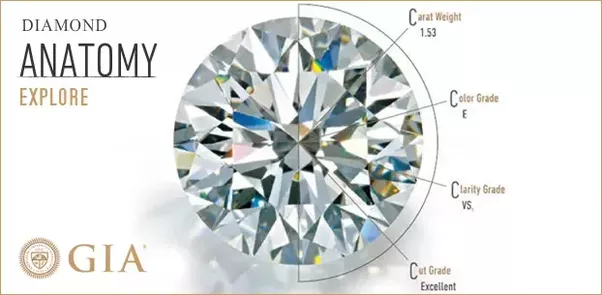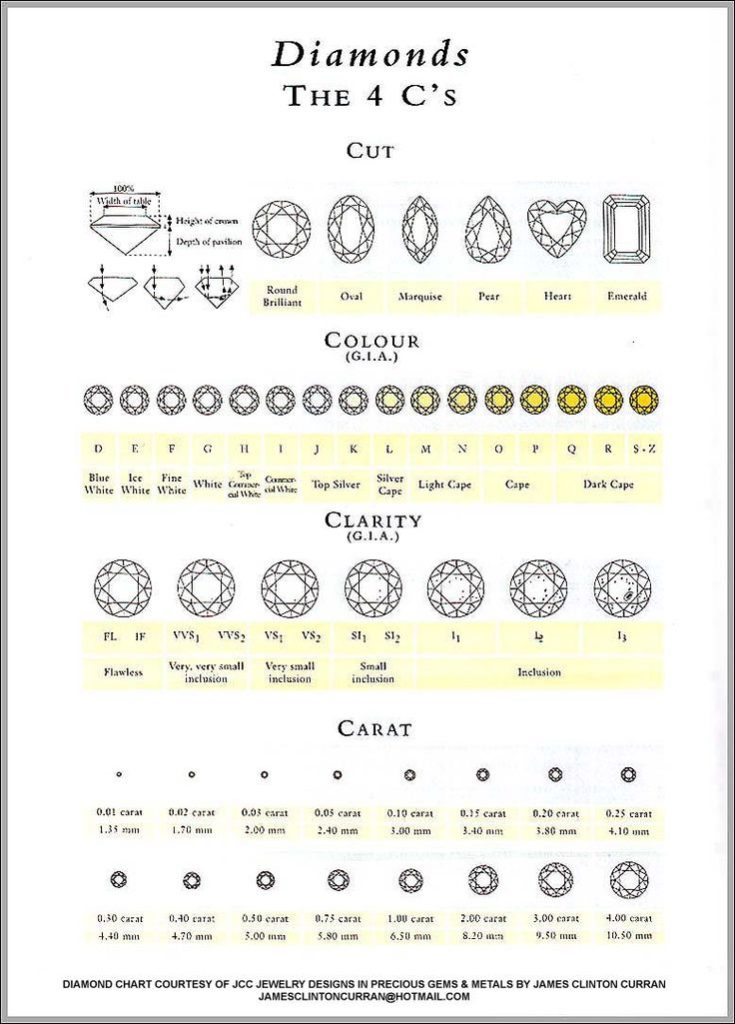A diamond value, rarity and beauty are determined by features that are commonly known as the 4 Cs. These refer to colour, clarity, carat and cut. Before deciding on purchasing a diamond or diamond in the jewellery, it is vital to understand why two diamonds that may look exactly the identical are actually valued differently. Before buying a diamond by understanding the 4 Cs in more detail it will give you a glimpse how to choose it the excellent quality, beauty and brilliant one.

quora.com
Cut
The cut is probably the most central, and most challenging, of the four Cs to understand. The brilliance of a diamond depends heavily on its cut the reason is cut has the greatest effect on a diamond’s beauty. There are three factors that determine a diamond’s cut quality:
- Proportions: the relative sizes and angles of the diamond’s parts and facets
- Symmetry: the precision of the cut design, especially the facets
- Polish: the smoothness and luster of the diamond’s surface
In determining the quality of the cut, the diamond grader evaluates the cutter’s skill in the fashioning of the diamond. The more precise the cut, the more captivating the diamond is to the eye. The cut grades are referenced on a diamond’s certificate often using the GIA standards of Excellent, Very Good, Good, Fair and Poor. For the most part, the actual measurements are mainly on the laboratory reports.
Color
Choosing the right color for your diamond is based on personal preference. However, it is notable to know that colorless diamonds are the most desirable since they allow the most refraction of light and colorless diamonds are the rarest.
Diamonds are colored when the crystals grow inside the earth. Tiny traces of some elements like nitrogen can color the crystals. In addition, the pressure involved in the diamond formation creates distortion in the crystal structure which is believed to also contribute to its color.
The color evaluation on gem-quality diamonds is based on the absence of color. The Gemological Institute of America (GIA) uses a 12-letter alphabetical scale of D to Z. Using this scale, the diamond on the lower end of the scale (D) will have the least amount of color – it is considered a colorless stone. The diamond at the higher end of the scale (Z) has deeper tones. However, when a diamond’s color is more intense than the “Z” grading, it enters the dominion of a “Fancy Color” diamond. In this case, the intensity of the color in the diamond can play a significant role in its value. The value of a Fancy Colored Diamond can exceed that of colorless diamonds if the intensity of the color is high and the color is rare.
For fancy diamonds, the value rises with the intensity of the color. Fancy colors include bright yellow, pink, champagne, blue and green. Red, purple and orange diamonds, though found in nature, are extremely exceptional.
Clarity
In the simple manner clarity is a measure of the tiny imperfections found in most every diamond. A flawless diamond with little to no imperfections is often desired due to its rarity, but they are also the most costly. Therefore, it is important to keep in mind that it is very common for diamonds to be formed with slight imperfections.
These imperfections are known as “inclusions” and usually occur during the diamond’s crystallization period within the earth, or from the stresses of mining and processing. Inclusions are anything from tiny white points to dark dots, cracks or scratches. The fewer inclusions, the more valuable a stone is. Clarity is evaluated using a 10-power magnification. This means that the object viewed appears 10 times its actual size. The diamond grader examines the clarity characteristics with respect to the nature and number of characteristics, as well as their size, color and position. The clarity grade assigned reflects the degree of visibility of the characteristics.
Diamonds often possess unique markings, either internal (known as inclusions) or external (known as blemishes). The examples of inclusions are such as cavity, carbon spot, scratch and blemishes are such as fracture, feather and pit. A diamond’s clarity grade depends on the absence or abundance of such inclusions and blemishes. The clarity grade of a diamond not only affects the value and price but can also be a good signal of the diamond’s vulnerability. Heavily included diamonds can be vulnerable to breakage.
Carat
The carat is the diamond’s physical weight measured in metric carats. One carat equals 1/5 gram and is subdivided into 100 points. Carat weight is the most objective grade of the 4Cs. Diamond prices increase with carat weight because larger diamonds are less common and more desirable. However, two diamonds of equal carat weight can have dramatically different values depending on three other factors: Color, Clarity and Cut. In jewellery pieces with more than one diamond, the carats are described in terms of total carat weight (T.W.). This is the combined total weight of all the diamonds in the piece. Determining the carat weight that is right for you depends primarily on your budget and taste.

And then there’s the “Fifth C” which is certificates. The diamond certificate, which is sometimes called a grading report, is a complete evaluation of your diamond that has been performed by a qualified professional with the help of special gemological instruments. Each stone bears its own recognizable, individual characteristics, which is listed on the certificate.





